Squatting position
Squatting is a posture where the weight of the body is on the feet (as with standing) but the knees and hips are bent. Squatting may be either:
- full - known as full squat, deep squat, (sitting) on one's haunches, (sitting) on one's hunkers, hunkering, hunkering down or hunkerin'
- partial - known as partial, standing, half, semi, parallel, shallow, intermediate, incomplete or monkey squat.
In contrast, sitting, involves taking the weight of the body, at least in part, on the buttocks against the ground or a horizontal object such as a chair seat. It is possible to squat with one leg and assume another position (such as kneeling) with the other leg. Crouching may involve squatting, kneeling or a combination of the two.[1] Among Chinese, Southeast Asian, and Eastern European adults, squatting often takes the place of sitting or standing.[2]
Etymology
As a verb - early 15th century. Squatting in the sense of "crouch on the heels" is from the Old French words esquatir and escatir. Squatting in the sense of "compress, press down, lay flat, crush" is from about 1400. Meaning "posture of one who squats" is from 1570s. Act of squatting is from 1580s. Weight-lifting sense is from 1954.[3]
Young children

Young children squat instinctively as a continuous movement from standing up whenever they want to lower themselves to ground level. One- and two-year-olds can commonly be seen playing in a stable squatting position, with feet wide apart and bottom not quite touching the floor, although at first they need to hold onto something to stand up again.[4]
Resting position
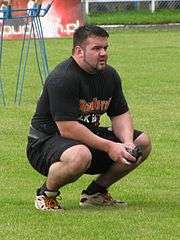
Full squatting involves resting one's weight on the feet with the buttocks resting on the backs of the calves. It may be used as a posture for resting or working at ground level particularly where the ground is too dirty or wet to sit or kneel.[1]
Most western adults cannot place their heels flat on the ground when squatting because of shortened Achilles tendons largely caused by habitually:
- sitting on chairs or seats
- wearing shoes with heels (especially high heels)
For this reason the squatting position is usually not sustainable for them for more than a few minutes as heels-up squatting is a less stable position than heels-down squatting.[5][6]
Catchers in baseball[7] and wicket-keepers in cricket assume full squatting positions. Australian wicket-keeper Sammy Carter (1878 to 1948) was the first to squat on his haunches rather than bend over from the waist (stooping).[8]
Hunkerin'
Hunkerin' is, in particular, the name applied to the American fad of resting in the squatting position in the late 1950s.
Hunkerin' had been in use in many cultures, particularly in Asia, for centuries when it suddenly became a fad in the United States in 1959.[9] Time reported that the craze started at the University of Arkansas when a shortage of chairs at a fraternity house led students to imitate their Ozark forefathers, who hunkered regularly.[10]
While the word "hunkerin'" is believed to originate from the Scots word for "haunches",[10] claims were made for Yorkshire, Korea and Japan.
The fad spread first to Missouri, Mississippi and Oklahoma, then across the U.S. While males were the predominant hunkerers, it was reported that female hunkerers were welcomed.[10] Within months, regional hunkerin' competitions were being held to discover champion hunkerers.[10]
Considered by authorities as preferable to the craze of the previous year, phonebooth stuffing,[10] people hunkered for hours on car roofs, in phone booths and wherever people gathered.[9] Life referred to it as "sociable squatting". Different styles of hunkerin' were reported as "sophisticates" tended to hunker flatfooted while others hunkered with their elbows inside the knees.[10]
Reasons for the popularity of hunkerin' included the ability for large groups of people to participate together peacefully to discuss issues such as politics or sport. When asked about the popularity of hunkerin', one hunkerer said hunkerin' was
"A respite from a world of turmoil. The main purpose of hunkerin' is to get down and hunker together. It's a friendship thing: get your friends to hunker with you. The man you don't know is the man you haven't hunkered with."[10]
By 1960 hunkerin' was less common.
Hunkerers urged United States President Dwight Eisenhower and General Secretary of the Communist Party of the Soviet Union Nikita Khrushchev to hunker together to end their differences.[10]
Gopniks
One of the distinctive characteristics of gopniks is that they will often be seen squatting, a learned behavior attributed to prison habits or disadvantaged origins.[11]
Grand Howl
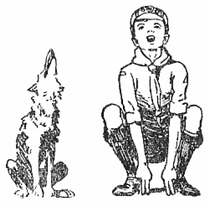
The Grand Howl is a ceremony used by Cub Scouts. It was devised by Robert Baden-Powell and is based on the Mowgli stories in Rudyard Kipling's Jungle Book. In the ceremony, Cubs act out the wolves greeting Akela, the "Old Wolf" at the Council Rock and are reminded of the Cub Scout Promise. For this ceremony cubs assume the squatting position to imitate a wolf's posture.
Childbirth position
Engelmann's seminal work "Labor among primitive peoples" publicised the childbirth positions amongst primitive cultures to the Western world. They frequently use squatting, standing, kneeling and all fours positions, often in a sequence.[12]
Various people have promoted the adoption of these alternative birthing positions, particularly squatting, for Western countries, such as Grantly Dick-Read, Janet Balaskas, Moysés Paciornik and Hugo Sabatino. The adoption of these alternative positions is also promoted by the natural childbirth movement.
The squatting position gives a greater increase of pressure in the pelvic cavity with minimal muscular effort. The birth canal will open 20 to 30% more in a squat than in any other position. It is recommended for the second stage of childbirth.[13]
As most Western adults find it difficult to squat with heels down, compromises are often made such as putting a support under the elevated heels or another person supporting the squatter.[14]
Sexual position
There are variations of the "cowgirl" sex position where the woman will be in a squatting position over the man, who is lying on his back, instead of kneeling over him. These are referred to by different names such as Asian cowgirl or frog squat position.
Female urination position
When not urinating into a toilet, squatting is the one way for a female to direct the urine stream (although many women find that they can do so standing up). If done this way, the urine will go forward downwards. Some females use one or both hands to focus the direction of the urine stream, which is more easily achieved while in the squatting position.
Acceptability of outdoor urination in a public place other than at a public urinal varies with the situation and with customs. In Western countries, males typically do this standing up, while females squat.
Hovering (partial squatting) is often used to avoid sitting on potentially unclean toilet seats, may leave urine behind in the bladder.[15]
Defecation position
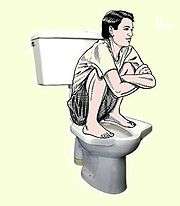
The squatting defecation posture involves squatting by standing with knees and hips sharply bent and the buttocks suspended near the ground. Squat toilets are designed to facilitate this posture. This is less common in the Western world.
Dynamic exercise
As strength training

In strength training, the squat is a full body exercise that trains primarily the muscles of the thighs, hips and buttocks, as well as strengthening the bones, ligaments and insertion of the tendons throughout the lower body. Squats are considered a vital exercise for increasing the strength and size of the legs and buttocks.
Burpee
The burpee is a full body exercise used in strength training and as an aerobic exercise. The basic movement is performed in four steps and known as a "four-count burpee". Step 1 requires you to drop into the squatting position.
Sit spin in figure skating
The sit spin is one of the three basic figure skating spin positions. It is defined by a squatting position in which the skater's buttocks are below the knee of the skating leg.[16]
Taoist Tai Chi
In Taoist Tai Chi, the "Dan Yu" (spine stretching) exercise involves squatting. It is intended to work primarily the pelvic region, the legs and the lower back. Fifty or more repetitions may be performed in advanced classes. The feet are placed in a stance wider than the shoulders. When squatting the knees move in the direction of the feet.[17][18][19]
Upavesasana in Yoga
Upavesāsana (literally sitting down pose), also known as the yoga squat, is an asana. Its name is often confused with mālāsana, a similar pose practiced with the feet together and the arms bound around the back.
The asana is a squat with heels flat on the floor and hip-width apart (or slightly wider if necessary), toes pointing out on a diagonal. The torso is brought forward between the thighs, elbows are braced against the inside of the knees, and the hands press together in front of the chest in Añjali Mudrā.[20]
Partial squat
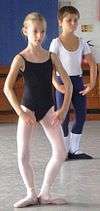

A partial squat (also known as standing, half, semi, parallel, intermediate, shallow, incomplete or monkey squat etc.) is an intermediate stage between standing and full squatting, that is, standing but with the knees and hips bent. (In contrast, stooping involves bending at the waist rather than just the knees and hips). It may be used in a variety of contexts often as a "ready for action" posture:
- the batsman's posture in cricket when waiting for a delivery.
- waiting to receive a serve in tennis
- used in the Alexander technique, as "the monkey squat" also known as the "position of mechanical advantage"[21]
- to avoid back strain it is important to bend the knees whenever you lift a heavy object.[22]
- plié in ballet is a type of partial squat balanced on the toes only and the legs turned outwards. (The grand plié has the thighs parallel to the ground like a parallel squat. The demi-plie has the thighs at about a 45% angle to the ground).
- the curtsey is a traditional gesture of greeting, in which a girl or woman bends her knees while bowing her head. It is the female equivalent of male bowing in Western cultures.[23]
- the parallel squat, often used in weight training, is just short of a full squat where the thighs are parallel to the ground.
- the most widely used martial arts stance is a shallow standing squat. This position is generally employed as it is a neutral and agile position from which both attacks and defences may be launched. It provides for the delivery of force when attacking and stability when defending.
- the sumo squat, with the legs wide apart, ready for action in sumo wrestling.
- Monkey Kung Fu a Chinese martial art which utilizes ape or monkey-like movements as part of its technique.
- a Besti squat is a figure skating move.
- twerking is "to dance to popular music in a sexually provocative manner involving thrusting hip movements and a low squatting stance".[24]
- the sorority squat is typically performed by sorority sisters immediately prior to a picture being taken where one or more participants slightly bend their knees and lean on their calves with their arms.[25][26]
- Garudasana and Utkatasana are partial squats in yoga asanas.
Lunging
A lunge is a variation of the partial squat where a leg is moved forwards with the knee bent but the other remains straight thus moving the upper body forward in line with the bent knee. For example:
- the snooker playing posture
- the fencing lunge
- the lunge as a weight training or strength training exercise.
Stalking, prowling and duckwalking
Stalking or prowling is essentially walking while in a partial squat. This is designed to be a walk that maintains a low profile, for example used by the military. The similar duckwalk is performed by assuming a low partial squatting position and walking forwards, maintaining the low stance.[27] It is a stage element of guitar showmanship popularized by Chuck Berry.[28][29]
Dancing
Squatting features heavily in some forms of dancing such as Cossack dancing.
Health effects
There is increased incidence of knee osteoarthritis amongst squatters who squat for hours a day for many years.[30] There is evidence that sustained squatting may cause bilateral peroneal nerve palsy. A common name for this affliction is squatter's palsy although there may be reasons other than squatting for this to occur.[31][32][33]
Tetralogy of Fallot
Older children will often squat during a Tetralogy of Fallot "tet spell". This increases systemic vascular resistance and allows for a temporary reversal of the shunt. It increases pressure on the left side of the heart, decreasing the right to left shunt thus decreasing the amount of deoxygenated blood entering the systemic circulation.[34][35]
Squatting facets
The existence of squatting facets on the distal tibia and talar articular surfaces of skeletons, which result from contact between the two bones during hyperdorsiflexion, have been used as markers to indicate if that person habitually squatted.[36][37]
Gallery of images
Full squats
 A cricket wicket-keeper in squatting position, ready to face a delivery.
A cricket wicket-keeper in squatting position, ready to face a delivery.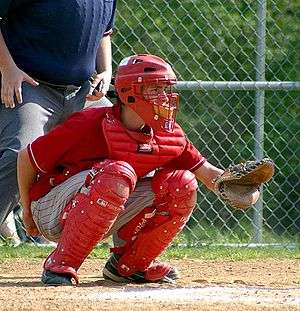
 A Balinese squatting wooden statuette.
A Balinese squatting wooden statuette. Young boy squatting in a park.
Young boy squatting in a park. Squatting used as part of a stress position for a Viet Cong prisoner.
Squatting used as part of a stress position for a Viet Cong prisoner.
Partial squats
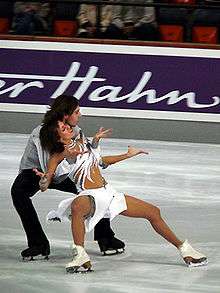 The Besti squat in figure skating.
The Besti squat in figure skating. A basic sit spin in figure skating.
A basic sit spin in figure skating.
See also
References
- 1 2 Hewes GW: 'World distribution of certain postural habits' American Anthropologist, 57, (1955), 231-44
- ↑ Dobrzynski, Judith H. (2004-10-17). "An Eye on China's Not So Rich and Famous". The New York Times. Retrieved 2010-04-07.
- ↑ Online etymology dictionary
- ↑ Slentz K, Krogh S Early Childhood Development and Its Variations (2001)
- ↑ Mauss, Marcel. Les Techniques du corps 1934. Journal de Psychologie 32 (3-4). Reprinted in Mauss, Sociologie et anthropologie, 1936, Paris: PUF.
- ↑ Bookspan, Jolie. "Save knees when squatting". Healthline.com. Retrieved 2013-11-24.
- ↑ See "Catcher's Stance" at Baseball-Catcher.com.
- ↑ The Oxford Companion to Australian Cricket, Oxford, Melbourne, 1996, p. 100.
- 1 2 Panati, Charles (1991). Panati's Parade of Fads, Follies, and Manias. New York: Harper Perennial. ISBN 978-0-06-055191-9. OCLC 24318503.
- 1 2 3 4 5 6 7 8 Staff writers (November 9, 1959). "Hanker to Hunker?". Time Magazine. Time. LXXIV (19). Archived from the original on 16 November 2011. Retrieved July 10, 2008.
- ↑ Ханипов Р. «Гопники» – значение понятия, и элементы репрезентации субкультуры «гопников» в России // "Social Identities in Transforming Societies"
- ↑ Engelmann GJ Labor among primitive peoples (1883)
- ↑ Russell JG. Moulding of the pelvic outlet. J Obstet Gynaecol Br Commonw 1969;76:817-20.
- ↑ "Balaskas J Using the squatting position during labour and for birth" (PDF). Retrieved 2013-11-24.
- ↑ "Preventing kidney infection". nhs.uk. National Health Service. 11 December 2012. Retrieved 22 September 2014.
- ↑ "ISU Communication No. 1445".
- ↑ Yang Chengfu (1931), Taijiquan Shiyongfa (Application methods of Taijiquan)
- ↑ Yang Chengfu (1934), Taijiquan Tiyong Quanshu (Complete Book of the Essence and Applications of Taijiquan)
- ↑ Yang Chengfu and Louis Swaim, tr. (2005). The Essence and Applications of Taijiquan. North Atlantic Books. ISBN 978-1-55643-545-4.
- ↑ "Garland Pose". Yoga Journal. Retrieved 2009-06-12.
- ↑ "The Monkey Squat". easyvigour.net.nz/. Retrieved 2014-09-09.
- ↑ "Lifting technique". Back.com. Retrieved 2013-11-24.
- ↑ Judith Martin (2005). Miss Manners' guide to excruciatingly correct behavior. W. W. Norton & Company. p. 692. ISBN 978-0-393-05874-1.
- ↑ Twerk, Oxford Dictionaries Online. Retrieved 28 August 2013
- ↑ Robbins A Pledged: The Secret Life of Sororities (2005)
- ↑ Sorority squat
- ↑ Duck walk
- ↑ Guitar Gods: The 25 Players Who Made Rock History. ABC-CLIO. 2008. p. 31. ISBN 978-0-313-35806-7. Retrieved 2010-02-17.
- ↑ Chuck Berry duck walk
- ↑ Liu CM, Xu L Retrospective study of squatting with prevalence of knee osteoarthritis - 2007
- ↑ Macpherson JM, Gordon AJ Squatter's palsy British Medical Journal, 1983
- ↑ Kumaki DJ. The facts of Kathmandu: squatter's palsy. Journal of the American Medical Association 2 Jan 1987;257(1):28.
- ↑ "Toğrol E. Bilateral peroneal nerve palsy induced by prolonged squatting. Mil Med. 2000 Mar;165(3):240-2". Findarticles.com. Retrieved 2013-11-24.
- ↑ Murakami T (2002). "Squatting: the hemodynamic change is induced by enhanced aortic wave reflection". Am. J. Hypertens. 15 (11): 986–8. doi:10.1016/S0895-7061(02)03085-6. PMID 12441219.
- ↑ Guntheroth WG, Mortan BC, Mullins GL, Baum D. Am Venous return with knee-chest position and squatting in tetralogy of Fallot. Heart J. 1968 Mar;75(3):313-8.
- ↑ Barnett CH Squatting facets on the European talus J Anat. 1954 October; 88(Pt 4): 509–513.
- ↑ Trinkaus E Squatting among the neandertals: A problem in the behavioral interpretation of skeletal morphology Journal of Archaeological Science Volume 2, Issue 4, December 1975, Pages 327-351
Further reading
Resting position
- Hewes GW: The anthropology of posture Scientific American, 196: 122-132 (1957)
- Jelenc KE and Raichlen DA Resting postures in human evolution: squatting, sitting, and the biomechanics of low back pain The 84th Annual Meeting of the American Association of Physical Anthropologists (2015) School of Anthropology, University of Arizona March 27, 2015
Dynamic exercise
- Escamilla, RF Biodynamics Knee biomechanics of the dynamic squat exercise Medicine & Science in Sports & Exercise: January 2001 - Volume 33 - Issue 1 - pp 127–141
Partiution
- Gardosi J., Hutson N Randomised, Controlled Trial Of Squatting In the Second Stage of Labour 1989 The Lancet, Volume 334, Issue 8654, Pages 74–77
- McKay S. Squatting: An Alternate Position For The Second Stage Of Labour The American Journal of Maternal/Child Nursing 1984;9:181-183.
- Nasir A., Korejo R., Noorani K.J. Child birth in squatting position. Journal of the Pakistan Medical Association 2007/1;57:19-22
- Paciornik M., Paciornik C., Birth in the Squatting Position (1979) Polymorph Films
- Paciornik M., Paciornik C., Commentary: arguments against episiotomy and in favor of squatting for birth. Birth 1990 Dec;17(4):234, 236. and Birth 1991 Jun;18(2):119.
- Paciornik M Use of the squatting position for birth. Birth 1992 Dec;19(4):230-1.
Health effects
- Chakravarty A, Chatterjee S.K., Chakrabarti S. Blood pressure changes during squatting—a study in normal subjects and its possible clinical significance. Journal of the Association of Physicians of India. 2001 Jun; 49(): 678-9
Circulation
- O'Donnell TV, McIlroy MB. The circulatory effects of squatting. American Heart Journal 1962 Sep;64:347-56.
- Sharpey-Schafer EP Effects of Squatting on the Normal and Failing Circulation Br Med J. 12 May 1956; 1(4975): 1072–1074.
External links
| Wikimedia Commons has media related to Crouching. |
- Health Benefits of the Natural Squatting Position
- Benefits of squatting
- The Squat Song
- Yoga Back Bends & Balancing Poses : Yoga Squat Pose
- Flat Footed Squat: How Homo Sapiens Sit
- Squatting Posture Baseball, Tantra, Yoga, Gardening
- Benefits of The Third World Squat
